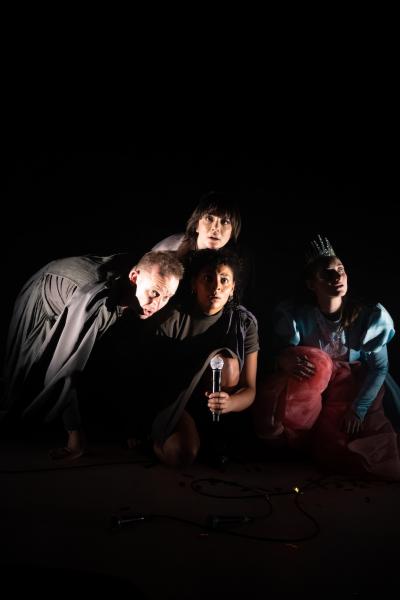Antigone
Written by Elena Carapetis, Antigone (after Sophocles) is a lot. As it should be, given the strident call to female power the work embodies. Its scope is grand - its themes, many big ideas, ideals and heightened emotion unfold over the 1 hour and 40 minute work.
On entry, Britney Spears’ Toxic is playing fairly loudly and more songs of that ilk follow. Meg Wilson’s stark, minimalist set frames the centre of the stage with curved, soft pink walls and floor, several hidden entrances, and central sculptural form - reminiscent of a Greek column remnant. The lighting rig sports a large, suspended, subtly illuminated magenta female ♀ symbol and the Welcome to Country ends with a countdown.

Bold text projected upstage relates a brief synopsis of Sophocles’ Antigone and a scene plays from the 1961 film version starring a riveting Irene Papas. Mark Saturno and Kidaan Zelleke enter and play out another version of the Creon/Antigone saga. Each episode sets the scene for female rebellion and the choice of action over suppression. As with the entire play, excellent use of space and elevated components is evident in Anthony Nicola’s fine direction.
As we speed two thousand years forward in time a demurely-frocked but eventually seething Kathryn Adams rails against what men are ‘allowed’ to get away with. At times the vignettes are punctuated with Saturno as an everyman casually speaking uncomfortable words that are later revealed to have originally emerged from the mouths of Trump, or Tony Abbott, with sexualised or misogynistic tones.

Chiara Gabrielli takes the stage to relate a chilling domestic violence tale that evolves poetically with potent symbolism edging toward magical realism. Saturno returns dressed in a slick suit topped by a disturbing hood suggestive of octopus tentacles and a visual nod to Mona Eltahawy’s analogy of the ‘patriarchy octopus’ - the head being the patriarchy and the tentacles reading as racism, capitalism, transphobia, misogyny, sexism, homophobia, ableism and ageism. This character holds forth orator/dictator style, often entreating all to “trust me” as he attempts to convince us his way is the only way. Zelleke intones regularly “there will be a man called…” and follows with the names of many hideous humans throughout history. Most are men but gradually a few women enter the list.
Jason Sweeney in his role of sound designer and composer has gifted the work with phenomenal depth and variety. At times a scene change is accompanied by raucous white noise. In another moment an ambient sound exists at the edge of hearing with a deep rhythmic pulse that could be a heartbeat, only to contrast with the irritating sound effects of a television game show. In another scene, the eerie sounds of Greek choristers can be heard as background to a heartfelt monologue by Kathryn Adams chronicling Carapetis’ personal, complicated relationship with God. In a surreal moment, with some impressively suggestive costume imagery, a Disney-style song becomes a highlight, due not only to the Carapetis/Sweeney magic but Adams’ prodigious vocal talent.

Elsewhere, a kidnapping situation unfolds with an epic rant by Saturno echoing the thoughts and rancid opinions of every privileged, white, male, power-broker with a sense of their own importance, bookended by Zelleke and her character’s stance on gun control. Gabrielli breaks the fourth wall as ‘Antigone’ in a suit and sneakers, armed with microphone, to deliver a crucial stand-up/stream of consciousness monologue covering a range of subjects dear to the MeToo movement, but much, much more. This section could be the pivot around which the entire action circles, such is its textual power and the strength of the actor’s delivery.
Each episode is marked by a dimming of the lights plus ‘running’ LEDs as actors efficiently shift set and platforms. Gavin Norris’ lighting design is complex and inventive including some states that are pure drama with tightly focussed spots and colour choices beautifully highlighting the director’s vision and the actors’ intentions. There is one confronting, fast-paced video projection too, giving snapshots of female-led protests and rebellions all over the world, which segues into the final ‘decisions’ made by the cast to alter the narrative and forge a new world.

There are more elements to this theatre work than space permits me to enlarge upon. It is also wonderful to note the prevalence of female artists contributing to both the creation and realization of Antigone, including some fine young actors who will no doubt shine bright in their future careers. They certainly have a huge impact in this production, standing tall beside Mark Saturno, a powerful, experienced performer. Additionally they have the benefit of working with the erudite and impactful writing crafted by Carapetis.
There was one sensitive monologue performed by Saturno that underscored the epidemic of male suicide. Initially, it seemed a strange inclusion but Carapetis goes deeper. The high number of males who suicide is but a symptom of a flawed way of existing where human systems that enable misogyny and the like also pave the way for the deeper feelings of males to be suppressed. If men are ‘taught’ to go out into the world and be warriors on many levels, their inner landscape is also a victim of patriarchy.

Antigone is an ode to the females who have embodied the spirit of the young heroine of Greek tragedy. Think Greta Thunberg, Malala Yousafzai, Grace Tame and Alexandria Ocasio-Cortez to name a few. It is a broad-reaching, original theatrical work that deserves a wide audience. I hope too that the conversation continues because the Patriarchy is still hovering.
Lisa Lanzi
Photographer: Matt Byrne
Subscribe to our E-Newsletter, buy our latest print edition or find a Performing Arts book at Book Nook.

